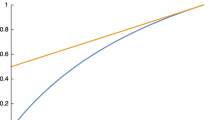Abstract
A general method is given for revising degrees of belief and arriving at consistent decisions about a system of logically constrained issues. In contrast to other works about belief revision, here the constraints are assumed to be fixed. The method has two variants, dual of each other, whose revised degrees of belief are respectively above and below the original ones. The upper [resp. lower] revised degrees of belief are uniquely characterized as the lowest [resp. greatest] ones that are invariant by a certain max-min [resp. min-max] operation determined by the logical constraints. In both variants, making balance between the revised degree of belief of a proposition and that of its negation leads to decisions that are ensured to be consistent with the logical constraints. These decisions are ensured to agree with the majority criterion as applied to the original degrees of belief whenever this gives a consistent result. They are also ensured to satisfy a property of respect for unanimity about any particular issue, as well as a property of monotonicity with respect to the original degrees of belief. The application of the method to certain special domains comes down to well established or increasingly accepted methods, such as the single-link method of cluster analysis and the method of paths in preferential voting.
Similar content being viewed by others
References
Arrow, K.J.: Social Choice and Individual Values, 2nd edn. Wiley, New York (1963)
Blake, A.: Canonical expressions in Boolean Algebra. Ph.D. dissertation, Univ. of Chicago (1937)
Brown, F.M.: Boolean Reasoning: The Logic of Boolean Equations. Kluwer, Norwell (1990)
Camps, R., Mora, X., Saumell, L.: A continuous rating method for preferential voting: the complete case. Soc. Choice Welf. (forthcoming). doi:10.1007/s00355-011-0548-z
Camps, R., Mora, X., Saumell, L.: A continuous rating method for preferential voting: the incomplete case. Soc. Choice Welf. (forthcoming). doi:10.1007/s00355-012-0663-5
Cohen, L.J.: The Probable and the Provable. Clarendon Press, Oxford (1977)
Dietrich, F., List, C.: The problem of constrained judgment aggregation. In: Stadler, F., et al. (eds.) The Present Situation in the Philosophy of Science, pp. 125–139. Springer, Heidelberg (2010)
Dietrich, F., List, C.: Propositionwise judgment aggregation: the general case. Soc. Choice Welf. (forthcoming). doi:10.1007/s00355-012-0661-7
Geanakoplos, J.: Three brief proofs of Arrow’s impossibility theorem. Econ. Theory 26, 211–215 (2005)
Guilbaud, G.Th.: Les théories de l’intérêt général et le problème logique de l’agrégation. Econ. Appl. 5, 501–584 (1952)
Hansson, S.O.: Logic of belief revision. In: Stanford Encyclopedia of Philosophy (2006). http://plato.stanford.edu/entries/logic-belief-revision/
Huber, F., Schmidt-Petri, C.: Degrees of Belief. Springer, Heidelberg (2009)
Jardine, N., Sibson, R.: Mathematical Taxonomy. Wiley, New York (1971)
Kornhauser, L.A.: Modelling collegial courts. II: Legal doctrine. J Law Econ. Organ. 8, 441–470 (1992)
Kornhauser, L.A., Sager, L.G.: The one and the many: Adjudication in collegial courts. Calif. Law Rev. 81(1), 1–59 (1993)
Kornhauser, L.A., Sager, L.G.: The many as one: Integrity and group choice in paradoxical cases. Philos. Public Aff. 32, 249–276 (2004)
List, C., Polak, B.: Introduction to judgment aggregation. J. Econ. Theory 145, 441–466 (2010)
Marquis, P.: Consequence finding algorithms. In: Gabbay, D.M., Smets, P., Kohlas, J. (eds.) Handbook on Defeasible Reasoning and Uncertainty Management Systems, vol. 5, pp. 41–145. Kluwer (2000)
McLean, I., Urken, A.B. (eds.): Classics of Social Choice. The University of Michigan Press, Ann Arbor (1995)
Monien, B., Speckenmeyer, E.: Solving satisfiability in less than 2n steps. Discret. Appl. Math. 10, 287–295 (1985)
Nehring, K., Puppe, C.: Consistent judgement aggregation: the truth-functional case. Soc. Choice Welf. 31, 41–57 (2008)
Nehring, K., Puppe, C.: Abstract Arrovian aggregation. J. Econ. Theory 145, 467–494 (2010)
Rescher, N.: Plausible Reasoning. Van Gorcum, Assen (1976)
Schulze, M.: A new monotonic and clone-independent single-winner election method. Voting Matters 17, 9–19 (2003)
Schulze, M.: A new monotonic, clone-independent, reversal symmetric, and Condorcet-consistent single-winner election method. Soc. Choice Welf. 36, 267–303 (2011)
Szpilrajn, E.: Sur l’extension de l’ordre partiel. Fundam. Math. 16, 386–389 (1930)
Tideman, T.N.: Collective Decisions and Voting: The Potential for Public Choice. Ashgate Publishing (2006)
Author information
Authors and Affiliations
Corresponding author
Electronic supplementary material
Below is the link to the electronic supplementary material.
Rights and permissions
About this article
Cite this article
Camps, R., Mora, X. & Saumell, L. A general method for deciding about logically constrained issues. Ann Math Artif Intell 64, 39–72 (2012). https://doi.org/10.1007/s10472-012-9292-z
Published:
Issue Date:
DOI: https://doi.org/10.1007/s10472-012-9292-z
Keywords
- Constrained judgment aggregation
- Degrees of belief
- Belief revision
- Plausible reasoning
- Artificial intelligence
- Decision theory
- Doctrinal paradox
- Cluster analysis
- Preferential voting
- Conjunctive normal forms




